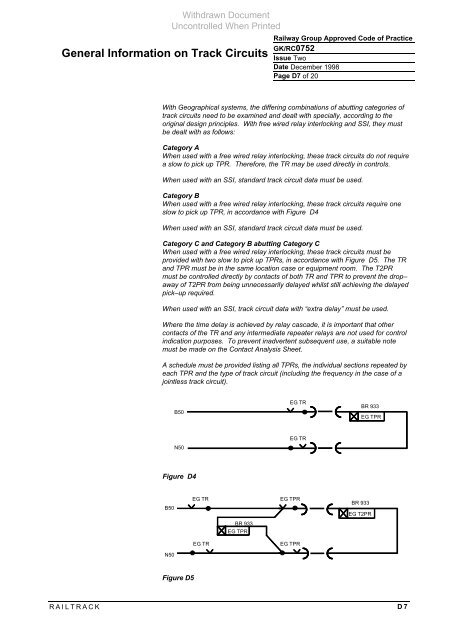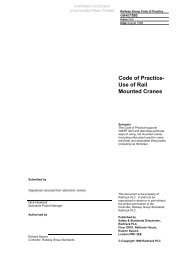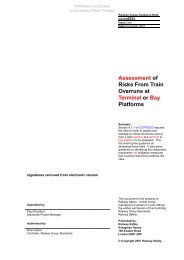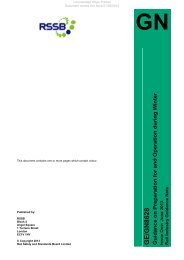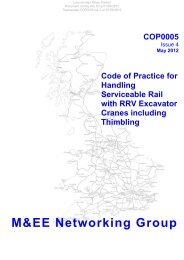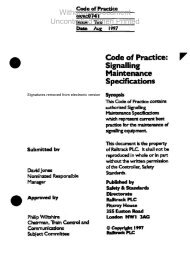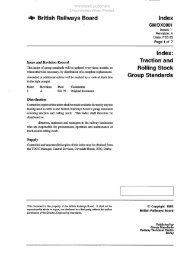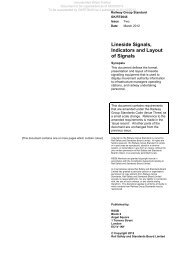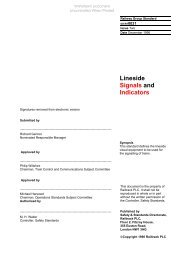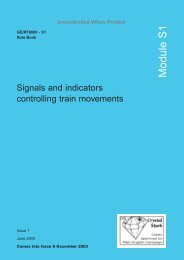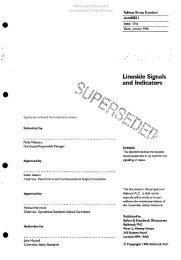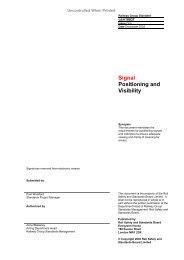General Information on Track Circuits - RGS Online
General Information on Track Circuits - RGS Online
General Information on Track Circuits - RGS Online
Create successful ePaper yourself
Turn your PDF publications into a flip-book with our unique Google optimized e-Paper software.
<str<strong>on</strong>g>General</str<strong>on</strong>g> <str<strong>on</strong>g>Informati<strong>on</strong></str<strong>on</strong>g> <strong>on</strong> <strong>Track</strong> <strong>Circuits</strong><br />
Railway Group Approved Code of Practice<br />
GK/RC0752<br />
Issue Two<br />
Date December 1998<br />
Page D7 of 20<br />
With Geographical systems, the differing combinati<strong>on</strong>s of abutting categories of<br />
track circuits need to be examined and dealt with specially, according to the<br />
original design principles. With free wired relay interlocking and SSI, they must<br />
be dealt with as follows:<br />
Category A<br />
When used with a free wired relay interlocking, these track circuits do not require<br />
a slow to pick up TPR. Therefore, the TR may be used directly in c<strong>on</strong>trols.<br />
When used with an SSI, standard track circuit data must be used.<br />
Category B<br />
When used with a free wired relay interlocking, these track circuits require <strong>on</strong>e<br />
slow to pick up TPR, in accordance with Figure D4<br />
When used with an SSI, standard track circuit data must be used.<br />
Category C and Category B abutting Category C<br />
When used with a free wired relay interlocking, these track circuits must be<br />
provided with two slow to pick up TPRs, in accordance with Figure D5. The TR<br />
and TPR must be in the same locati<strong>on</strong> case or equipment room. The T2PR<br />
must be c<strong>on</strong>trolled directly by c<strong>on</strong>tacts of both TR and TPR to prevent the drop–<br />
away of T2PR from being unnecessarily delayed whilst still achieving the delayed<br />
pick–up required.<br />
When used with an SSI, track circuit data with “extra delay” must be used.<br />
Where the time delay is achieved by relay cascade, it is important that other<br />
c<strong>on</strong>tacts of the TR and any intermediate repeater relays are not used for c<strong>on</strong>trol<br />
indicati<strong>on</strong> purposes. To prevent inadvertent subsequent use, a suitable note<br />
must be made <strong>on</strong> the C<strong>on</strong>tact Analysis Sheet.<br />
A schedule must be provided listing all TPRs, the individual secti<strong>on</strong>s repeated by<br />
each TPR and the type of track circuit (including the frequency in the case of a<br />
jointless track circuit).<br />
B50<br />
N50<br />
Figure D4<br />
B50<br />
N50<br />
Withdrawn Document<br />
Unc<strong>on</strong>trolled When Printed<br />
Figure D5<br />
EG TR<br />
EG TR<br />
BR 933<br />
EG TPR<br />
RAILTRACK D7<br />
EG TR<br />
EG TR<br />
EG TPR<br />
EG TPR<br />
BR 933<br />
BR 933<br />
EG TPR<br />
EG T2PR


